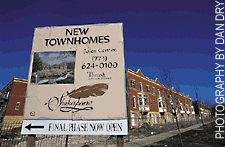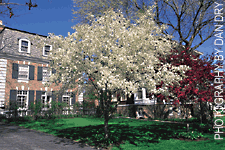Outside
opinion confirms this picture of an affluent, educated
populace. An international market-research company called Claritas,
based in Arlington, Virginia, divides the nation's multitudes
into 50 demographic groups, and 62 lifestyle (or purchasing) clusters,
then sells very localized information to retailers who want to
avoid building a Champagne store in a Budweiser neighborhood.
According to Claritas, central Hyde Park--Kenwood is totally Taittinger.
Within a half mile radius of the intersection of Kenwood and 54th,
60 percent of adults are what the company labels "Urban Up and
Comers," young people in white-collar occupations, with high levels
of education and medium-high incomes. More than 40 percent of
those over 25 have graduate degrees. "Up and Comers" play tennis,
eat out, travel abroad, and read the Wall Street Journal.
South of 55th Street, Comers most often fit the lifestyle cluster
the company calls "Young Literati": serious readers who pop vitamins,
plan for purchases, peruse GQ. North of 55th one finds more "Bohemian
Mix," also white collar but more likely to shop at the Gap, skim
Elle, watch Face the Nation. Hyde Park also harbors
a sizeable block of "Movers and Shakers," older, highly educated,
dual-income couples who browse Business Week, and listen
to National Public Radio.
Push out a mile farther, into the upper 60s or the lower 40s,
and you begin to see the limits of South Side revitalization.
Despite the burgeoning real estate booms in Woodlawn and North
Kenwood, "Up and Comers" gradually give ground to "Metro Mix,"
a group with less education. "Metro Mix" often segues into "Difficult
Times"--single-parent families with higher unemployment.
 |
| Location,
location, location: the
combination of urban and more bucolic vistas makes Hyde Park
a more and more attractive place to live. |
Within
Hyde Park--Kenwood, however, the seller's market has progressed
to phase two, from residential to retail. All those Comers and
Shakers have attracted more and more businesses to the neighborhood.
People from all over Chicago have always come to Hyde Park to
buy books. Now people from Hyde Park no longer have to go all
over Chicago to buy everything else. "The number of businesses
has skyrocketed," says Irene Sher, commercial real estate guru
for the SECC. Recent additions include a new Ace hardware store,
an Office Depot outlet, more specialty boutiques along 53rd Street,
and multiple access to Starbucks coffee. Residents can pick up
a lamp, note-taking equipment, a scone, and a latte to support
their reading habits.
Retail
offerings have expanded enough to create some tensions among long-term
residents, who worry that accelerated growth could replace the
tranquility and character of neighborhood shops with the clutter
and commotion they associate with the North Side. Alderman Preckwinkle's
office has been working for more than a year with the City's department
of planning to secure a tax increment funding (TIF) district along
53rd Street. For 23 years, all increases over the area's initial
property tax levies will be used to fund development, making the
area more attractive to a "better mix" of retailers, via enhanced
streetscaping and off-street parking, a prospect that concerns
some, who fear that it could raise rents, driving out the smaller
businesses such as Rajun Cajun, a creole/Indian eatery that caters
to local tastes and budgets, in favor of cookie-cutter national
chains.
"I'm
not worried about commercialization," says broadcaster Ferguson,
"but I want it to reflect the values of the community and not
be imposed. No one wants Borders Books to come in here and threaten
the Seminary Co-op bookstores. But I think we can handle both,
we can have planned retail growth without endangering our uniqueness."
Jo Reizner, director of real estate for the University, echoes
her sentiments. She admits that "Most Hyde Parkers do want
more retail outlets, more places to shop," quickly adding, "but
not all that much more."
Universally
welcomed, however, is the influx of new and varied restaurants.
Eating out in the 1970s meant choosing between Thai cuisine and
the Valois, Gallic for "see your food." Now three local restaurants
rate stars in either the Chicago Tribune or Chicago
magazine: southern cooking at the Dixie Kitchen, Caribbean cuisine
at Calypso, and at long last French, La Petite Folie, which has
become the leading local spot for faculty recruitment dinners.
Better
housing, less crime, more services, "all these improvements add
up," says Webber. "You don't have huge progress every day or even
every week, but you chip away. Robie House opening as a full-time
museum: there's a big improvement. A lawn in front of the Museum
of Science and Industry rather than a sea of parking lots: that
matters.
"There
are still problems, of course. Parking was bad and has gotten
worse, and as we add more students, it will be worse still until
a new garage opens," a 1,000-space facility on 55th Street between
Ellis and Greenwood Avenues this December.
"And
we need more affordable houses with yards," Webber continues.
"I think Woodlawn and North Kenwood are our future there. But
on the whole, Hyde Park is a much, much better place than it was
20 or even 10 years ago. The University played a big role in that
and the fact that we're about to invest another $500 million in
new campus construction sends a powerful message. But lots of
people deserve lots of credit."
The
improvements, large and small, seen all over the neighborhood,
do add up. Accumulated over an afternoon tour, they seem to have
won over the poet's partner, Jeff Chase. Dyrud found him two places
he liked, a third-floor condominium on Everett, with two porches,
lake view--at least in leafless seasons, if you're over six-foot--and
a dining room painted "willow." He also liked East View Park;
elegant older structures, again near the lake, in a park-like
setting, and no dogs. "This place has a nice kind of quiet," he
tells her. "I like it."
"Good,"
she replies with genuine pleasure, heading back to the office.
"I just wanted to persuade you that you can find a place here.
I wanted to convince you that this is a lovely neighborhood."
"I
am pleased to say," Chase responds with equal sincerity, "that
you have done that."



![]()

